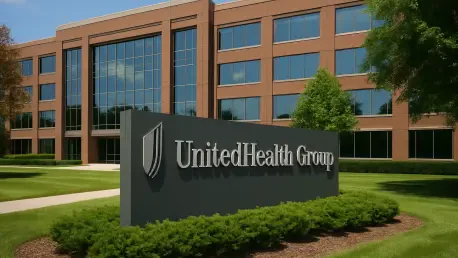UnitedHealth Group, a titan in the healthcare industry, finds itself grappling with a perplexing financial conundrum in the second quarter of the current year, as revenue surges fail to translate into expected profits. Despite posting an impressive $116.6 billion in revenue, up significantly from the prior year’s $98.85 billion, the company’s profit plummeted to $3.4 billion, down from $4.2 billion in the same period last year. This stark contrast between top-line growth and bottom-line struggles raises critical questions about the sustainability of the company’s financial model. Rising medical costs, operational missteps, and external pressures have cast a shadow over the conglomerate’s performance, particularly with its subsidiary Optum falling short of expectations. As stakeholders scrutinize these results, the central issue remains whether UnitedHealth can navigate these turbulent waters to restore profitability and investor confidence in the near future.
Financial Performance: A Tale of Growth and Decline
The financial landscape for UnitedHealth Group in Q2 reveals a complex narrative of robust revenue expansion overshadowed by a troubling profit shortfall. The company’s revenue leap to $116.6 billion showcases its ability to grow its market presence and customer base, reflecting strength in its core operations. However, the drop in profit to $3.4 billion signals deeper issues, primarily driven by a consolidated medical care ratio that spiked to 89.4%, a sharp rise of 430 basis points compared to the previous year. This increase stems from medical cost trends outpacing pricing adjustments, with higher unit costs and intensified service demands playing significant roles. Additionally, Medicare funding reductions have squeezed margins further, while an unfavorable medical reserve development of $70 million added to the financial strain. These factors combined paint a picture of a company struggling to balance growth with cost control, highlighting the urgent need for strategic adjustments to stabilize earnings.
Beyond the headline numbers, the profit decline in Q2 underscores systemic challenges that UnitedHealth must address to maintain its competitive edge. The disparity between revenue and profit suggests inefficiencies in cost management, particularly as medical expenses continue to outstrip pricing strategies. The impact of Medicare funding cuts cannot be understated, as they directly affect the company’s ability to deliver services at sustainable rates. Moreover, the unexpected reserve development issues indicate potential gaps in forecasting and risk assessment, which could erode trust among investors if not rectified swiftly. While the first half of the year showed an overall profit improvement to $9.7 billion compared to a cyberattack-marred prior period, the persistent bottom-line weakness in Q2 raises alarms. For UnitedHealth, the path forward hinges on tightening operational controls and recalibrating financial models to better align costs with revenue streams, ensuring long-term stability.
Optum’s Struggles and Recovery Prospects
UnitedHealth’s subsidiary, Optum, emerged as a significant contributor to the Q2 profit shortfall, reporting earnings $6.6 billion below expectations, a setback that has drawn intense scrutiny. Leadership at Optum, under CEO Patrick Conway, pointed to accelerated medical cost trends, lower service volumes, and misjudgments in assessing new members’ risk profiles as key culprits behind the disappointing results. These issues reflect broader challenges in adapting to shifting healthcare dynamics, where cost pressures and demographic changes can quickly disrupt financial projections. Conway has expressed a commitment to turning the tide, outlining a multi-pronged improvement plan that prioritizes consistency in clinical models and margin recovery in value-based care. While a meaningful recovery is projected for next year, the longer timeline for value-based care suggests that some challenges may persist, requiring patience from stakeholders.
Delving deeper into Optum’s recovery strategy, the focus on aligning benefits with payer partners and phasing out certain product arrangements indicates a shift toward more sustainable operational frameworks. The emphasis on enhancing clinical consistency aims to reduce variability in care delivery, which could help curb escalating costs over time. However, the underestimation of member risk profiles points to a critical need for improved data analytics and predictive modeling to better anticipate healthcare needs. As Optum works toward these goals, the broader implications for UnitedHealth are significant, given the subsidiary’s role as a key growth driver. The projected recovery timeline offers a glimmer of hope, but success will depend on execution and the ability to adapt to evolving market conditions. For now, Optum’s struggles serve as a cautionary tale of the complexities inherent in managing large-scale healthcare operations under mounting cost pressures.
External Pressures and Strategic Outlook
Beyond internal financial woes, UnitedHealth faces a barrage of external challenges that complicate its path to recovery, including legal and regulatory scrutiny that could impact its reputation and operations. A Department of Justice investigation into alleged healthcare fraud tied to Medicare Advantage practices has added a layer of uncertainty, potentially affecting investor sentiment and strategic planning. Additionally, a shareholder lawsuit filed earlier this year accuses the company of misleading investors about its financial outlook following a tragic executive loss late last year, raising questions about transparency and governance. These external pressures compound the financial strain, creating a multifaceted crisis that demands careful navigation. The convergence of legal battles and regulatory oversight underscores the importance of robust compliance measures and clear communication with stakeholders to mitigate risks.
Looking at the strategic response, UnitedHealth has revised its full-year outlook, projecting earnings per share of approximately $16 and revenue between $445.5 billion and $448 billion, with specific targets for its core divisions. CEO Stephen Hemsley has emphasized a renewed focus on operational discipline and positioning for growth in the coming years, framing these efforts as part of a mission to serve broader health needs. This forward-looking stance suggests confidence in overcoming current hurdles, but the effectiveness of these initiatives remains to be seen. The external challenges, particularly legal disputes, could divert resources and attention from core recovery efforts if not managed adeptly. As UnitedHealth charts its course, balancing these external pressures with internal reforms will be critical to rebuilding trust and achieving sustainable profitability in a competitive and heavily regulated industry.
Path to Financial Resilience
Reflecting on the tumultuous Q2, UnitedHealth Group faced a landscape where impressive revenue gains were eclipsed by profit declines and operational setbacks, particularly within its Optum subsidiary. The sharp rise in medical costs and external pressures like regulatory investigations tested the company’s resolve, revealing vulnerabilities in cost management and risk assessment. Despite these challenges, leadership has shown a proactive approach by revising full-year projections and committing to strategic improvements. Moving forward, the focus must shift to actionable steps such as refining data-driven risk models, enhancing clinical consistency, and strengthening compliance frameworks to address both internal inefficiencies and external scrutiny. By prioritizing these areas, UnitedHealth can aim to rebuild investor confidence and pave the way for a stronger financial footing in the years ahead, turning past struggles into a foundation for enduring resilience.









